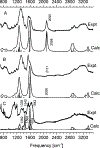Platinum (II) complex-nuclear localization sequence peptide hybrid for overcoming platinum resistance in cancer therapy
- PMID: 32042890
- PMCID: PMC7009786
- DOI: 10.1021/acsbiomaterials.7b00921
Platinum (II) complex-nuclear localization sequence peptide hybrid for overcoming platinum resistance in cancer therapy
Abstract
Platinum therapy represents first line of treatment in many malignancies but its high systemic toxicity limits the therapeutic dosage. Herein, we report the synthesis of carboplatin-like complexes with azide and alkyne functional groups and the formation of a platinum (II) - nuclear localization sequence peptide (Pt-NLS) hybrid to improve the import of platinum (II) complexes directly into the cell's nucleus. The Pt-NLS hybrid successfully enters cells and their nuclei, forming Pt-induced nuclear lesions. The in vitro efficacy of Pt-NLS is high, superior to native carboplatin at the same concentration. The methodology used is simple and cost-effective and most importantly can easily be extended to load the Pt (II) onto other supports, opening new possibilities for enhanced delivery of Pt (II) therapy.
Keywords: NLS peptides; chemoresistant; click chemistry; platinum (II) complexes.
Figures




Similar articles
-
Nuclear localization signal-targeted poly(ethylene glycol) conjugates as potential carriers and nuclear localizing agents for carboplatin analogues.Bioconjug Chem. 2004 Jul-Aug;15(4):814-23. doi: 10.1021/bc0499331. Bioconjug Chem. 2004. PMID: 15264869
-
The chemistry and biology of platinum complexes with the 1,2-diaminocyclohexane carrier ligand (review).Int J Oncol. 1995 Jun;6(6):1291-305. doi: 10.3892/ijo.6.6.1291. Int J Oncol. 1995. PMID: 21556672
-
An alkyne-appended, click-ready Pt(II) complex with an unusual arrangement in the solid state.Angew Chem Int Ed Engl. 2015 Jan 12;54(3):1032-5. doi: 10.1002/anie.201409853. Epub 2014 Nov 27. Angew Chem Int Ed Engl. 2015. PMID: 25429919
-
Recent Advances in Platinum (IV) Complex-Based Delivery Systems to Improve Platinum (II) Anticancer Therapy.Med Res Rev. 2015 Nov;35(6):1268-99. doi: 10.1002/med.21360. Epub 2015 Aug 17. Med Res Rev. 2015. PMID: 26280923 Review.
-
Reactions of Dinuclear Platinum(II) Complexes with Peptides.Curr Protein Pept Sci. 2016;17(2):95-105. doi: 10.2174/138920371702160209120921. Curr Protein Pept Sci. 2016. PMID: 26521953 Review.
Cited by
-
Investigating the role of peptides in effective therapies against cancer.Cancer Cell Int. 2022 Mar 27;22(1):139. doi: 10.1186/s12935-022-02553-7. Cancer Cell Int. 2022. PMID: 35346211 Free PMC article. Review.
-
H-Dot Mediated Nanotherapeutics Mitigate Systemic Toxicity of Platinum-Based Anticancer Drugs.Int J Mol Sci. 2023 Oct 23;24(20):15466. doi: 10.3390/ijms242015466. Int J Mol Sci. 2023. PMID: 37895146 Free PMC article.
-
A click-based modular approach to introduction of peroxides onto molecules and nanostructures.RSC Adv. 2020 Dec 16;10(72):44408-44429. doi: 10.1039/d0ra09088c. eCollection 2020 Dec 9. RSC Adv. 2020. PMID: 35517136 Free PMC article.
-
Identification and validation of a novel risk model based on cuproptosis‑associated m6A for head and neck squamous cell carcinoma.BMC Med Genomics. 2024 May 22;17(1):137. doi: 10.1186/s12920-024-01916-5. BMC Med Genomics. 2024. PMID: 38778403 Free PMC article.
-
Recent advances in metallopolymer-based drug delivery systems.RSC Adv. 2019 Nov 13;9(63):37009-37051. doi: 10.1039/c9ra06678k. eCollection 2019 Nov 11. RSC Adv. 2019. PMID: 35539076 Free PMC article. Review.
References
-
- Galanski M; Jakupec MA; Keppler BK Update of the preclinical situation of anticancer platinum complexes: novel design strategies and innovative analytical approaches. Curr. Med. Chem 2005, 12, 2075–2094. - PubMed
-
- Fichtinger-Schepman AM; van Oosterom AT; Lohman PH; Berends F cis-Diamminedichloroplatinum(II)-induced DNA adducts in peripheral leukocytes from seven cancer patients: quantitative immunochemical detection of the adduct induction and removal after a single dose of cis-diamminedichloroplatinum(II). Cancer Res. 1987, 47, 3000–3004. - PubMed
-
- Reishus JW; Martin DS Jr. cis-Dichlorodiammineplatinum(II). Acid hydrolysis and isotopic exchange of the chloride ligands. J. Am. Chem. Soc 1961, 83, 2457–2462, DOI: 10.1021/ja01472a009. - DOI
Grants and funding
LinkOut - more resources
Full Text Sources
